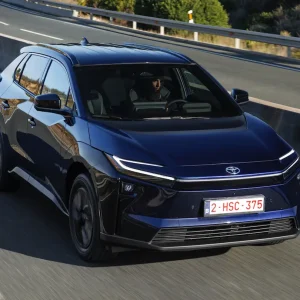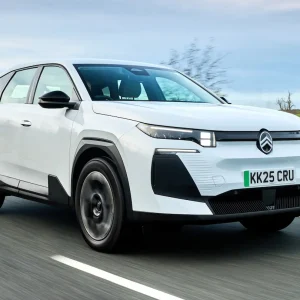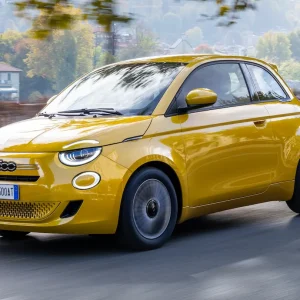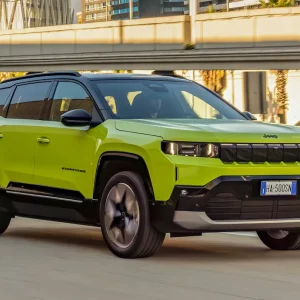
Final Report: Grand finale
Recently, I attended two car launch events on successive weeks for Business Car, well up in the north of England. That meant trips of more than five hours in each direction, augmented on the first excursion in particular by some heavy traffic and inclement weather. It could have been a horror story, but the truth is our C5 Aircross made the journeys seem easy and straightforward. OK, this was in part due to features lots of cars have these days, such as an automatic gearbox and adaptive cruise control. However, there’s also the degree to which the car’s ‘Advanced Comfort’ seats and suspension live up to their name, and in a marketplace where so many unsuitable models are given ‘sports-inspired’ firmness, I’m confident few alternatives would have left me arriving at my destinations feeling so fresh. In addition, where some cars’ phone-to-touchscreen connections can be unreliable, the Citroen’s never missed a beat, meaning my sanity-preserving stream of music and podcasts was never interrupted.
It seemed a pretty strong test finale for the C5 Aircross, which is approaching the end of its time on our fleet. However, it’s far from just being a motorway specialist. I’ve commented before on its spacious interior, with three individual rear seats (that can all slide, recline, and fold separately), but hadn’t realised until recently, when helping friends to shop for a family car, the degree to which it excels here. In fact, with the exception of the more expensive Range Rover Evoque, it’s the widest C-segment SUV available by a good few centimetres – including in comparison with other Stellantis group SUVs on the same platform. And that’s a difference not to be sniffed at by those regularly transporting three rear seat passengers, or alternatively needing to accommodate a child seat or two.
As I’ve relayed before over my time with the C5 Aircross, there are some niggles. There’s the way petrol will sometimes spurt back out when the car is filled with fuel. And there’s the way that, on occasion, the electric tailgate begins closing itself on my head for no apparent reason – and needs a surprising degree of resistance on my part to realise the error of its ways and cease its ingress.
One thing that isn’t the car’s fault though is its fuel economy. I have no home charger, and it came with no three-pin plug cable, so charging was an extremely scarce occurrence, which we should all know by now is definitely not the way to run a plug-in hybrid – my 38.8mpg average is yet further proof that drivers unable to charge should be directed to alternative powertrains. Still, at least the PHEV’s 225hp total output offers strong performance.
Overall, in my view there’s a lot more that’s good than bad about the C5 Aircross, and although for my personal requirements a diesel (remember those?) might have been better, I can imagine that for a driver who has a family to transport, prioritises ride comfort over sporty handling, and who has the home charger and mileage patterns required for a plug-in hybrid to make sense, our test car would be a real winner.
5th Report: Trading places
As Business Car readers are no doubt aware, platform-sharing is increasingly common these days in the car industry, as different brands within groups look to make efficiencies by reusing the same mechanical underpinnings for their models. But how similar really are the cars that result? Well, I recently got to make a comparison in the context of our Citroen C5 Aircross long-termer by driving the newly facelifted DS 7, another Stellantis group C-segment SUV based on the same EMP2 platform (also shared by the likes of the Peugeot 3008 and Vauxhall Grandland).
Coming from a premium brand in the Stellantis portfolio, the DS 7 unsurprisingly has a higher-quality interior than the C5, although the Citroen’s is hardly a disappointment, since despite some scratchier plastics being present, areas you regularly touch are good quality, including leather on places such as the interior door handles and steering wheel. In addition, while a cream colour scheme made the DS’s interior stylish and attractive, we have to imagine our Citroen’s more conventional, darker palate would be more practical for families. In the same vein, the DS misses out on the C5’s individually folding rear seats – featuring instead the more commonplace 60/40 split fold – and while a sunroof in the car we drove does help to illuminate the interior, it also reduces headroom in comparison with the Citroen.
The DS 7 is available with more powerful plug-in hybrid powertrains than the C5, and the 300hp version I tried was noticeably quicker from behind the wheel than our 225hp long-termer. Also noticeable, despite the same architecture, is different chassis tuning, with the DS feeling sportier, and it also features four-wheel drive, thanks to the presence of an extra electric motor, which would no doubt be of benefit in inclement weather. However, despite its less premium image, the Citroen’s focus on ride comfort does mean it bests the DS in this area. We also prefer the Citroen’s more conventional automatic gear shifter for manoeuvring to the DS’s less intuitive set-up.
Overall, the DS does have a lot of good points and higher-quality elements – as you would expect given a price premium of around £11,000 for an equivalent spec. However, the Citroen is by no means disgraced by the comparison – and in fact, for families, might even be the better option regardless of price.
Unfortunately though, there is also a more negative aspect of the C5 that I feel I should touch on this month. There is a tendency, when the fuel tank is filled, for some petrol to come spurting back out as the pump clicks off. This isn’t something I’ve encountered on a vehicle before, and happens repeatedly, meaning I need to take care to keep my fingers clear to avoid an unwanted splashing with unleaded. The C5 does have a pressurised fuel tank, which has to be depressurised by pressing a button on the dashboard before fuelling can take place, and I don’t know if this is somehow linked. But whatever the cause, it’s an unwelcome irritation.
4th Report: And now for the good news
At the end of last month’s report, I noted that the bulk of my previous two write-ups about the C5 Aircross had been largely negative, and not always for reasons that were the car’s fault. So, to redress the balance, here are some things that I’ve liked so far.
Firstly, I observed when the car arrived the presence of ‘Advanced Comfort’ seats and suspension on the spec sheet, and voiced the hope that this would make it a relaxing way of covering miles, and I’m pleased to report that this is exactly how it’s bearing out. Ride comfort is a clear level above most other family cars – something that has been observed by passengers as well as by myself, and helps to ensure that I end long journeys still feeling fresh, when combined with the automatic gearbox and adaptive
cruise control.
Something else passengers have noted, perhaps more surprisingly, is the impressive acceleration provided by the plug-in hybrid powertrain. This isn’t something I really notice day to day – and clearly with the aforementioned comfort features this isn’t a car that had sporty driving as a high design priority – but with a total of 225hp coming from the petrol engine and electric motor there is ample shove – enough indeed for
Citroen’s sister brand Vauxhall to use it as the basis for its sporty Astra GSe model. With its heavier SUV body, the C5 Aircross won’t quite match the performance of that car, but its in-gear acceleration is easily up to any motorway joining or overtaking manoeuvre, and helps it keep pace nicely with traffic on twistier roads.
Some notes on practicality. I’ve observed with previous SUV tests that I’m not necessarily the best correspondent to assess this as I don’t have any children to ferry around, however one thing I have noticed is that the door bins are impressively large – easily able to accommodate several water bottles and a lunch box each on active day trips. In addition, while having three individual rear seats may be a welcome feature in terms of aiding passenger comfort, it does also make it possible to access the boot from the car’s interior by folding one down while inside – done simply by pulling a single toggle – to create a makeshift ski-flap, which is a useful feature if you want to change your shirt in inclement weather conditions as I did recently.
Finally – and this may seem rather obscure – I do like the neat design of the windscreen washer bottle. When I first went to fill it I couldn’t work out quite what was happening as there seemed to be some sort of permeable membrane over the neck, but on closer inspection found there was an integrated sieve. This prevents the screen wash overflowing and splashing around as it’s poured in. It might be this is a necessity, as a quick right angle in the neck of the bottle would make it impossible to insert a funnel, but still, it’s a solution that appeals to me.
3rd Report: PHEV folly?
A couple of months into my time with the Citroen C5 Aircross, I feel it’s time to address the elephant in the room. I am committing the cardinal plug-in hybrid sin of barely ever plugging it in to charge.
To a certain extent this is unavoidable, due to the obstacles in the way of me following the generally recommended policy of regularly charging at home. Although I have off-street parking outside my house, there is no EV charger, and while I could technically use a three-pin inside plug socket, the prospect of having a living room window open in winter to facilitate this doesn’t really appeal. And anyway – and understandably – no three-pin cable was supplied with our test car.
But what about public charging? Well, this leads me to an element of plug-in hybrids that I hadn’t really considered before I ran one. With constant news these days about ultra-fast charging hubs opening, and the latest full EVs being able to add hundreds of miles of range in minutes, it’s easy to overlook that the picture for plug-in hybrids is often very different. With the C5 Aircross, the maximum charging rate is 7kW – no problem at all if you can home-charge of an evening, since the battery can be fully replenished at this rate in a couple of hours. But remember, this is the maximum charge rate wherever you are, even if using a public charger that can handle more.
For instance, my nearest charger is in a town centre car park, and is capable of up to 22kW charging. But on a recent shopping trip, a 50-minute charge only added nine miles of range. Bearing in mind many of my miles in the Citroen are on long-range motorway trips, you can see how charges of this sort are only going ever to make the merest dent in the car’s overall fuel economy figures, and the idea of topping up during service station coffee breaks as advised for full EV drivers would be next to useless – even before we get to the consideration of how relatively expensive public charging can be at the moment.
The upshot of all this is that as things stand, my average fuel economy figure with our car is relatively poor, at 38.4mpg – which, as well as being inevitably miles off the official figure for the plug-in hybrid, is also a chunk worse than the official figures for the petrol and diesel variants.
Another downside of running our C5 Aircross in this way is its relatively small fuel tank. To help accommodate the battery, the plug-in hybrid version features a 43-litre tank, compared with a 53-litre tank for ICE versions. And combined with the aforementioned poor economy I’m getting, this means fairly regular trips to the pumps – just under 350 miles is my longest range between fill-ups so far.
Of course, none of the above should really be much of a surprise to anyone reading this, and at least I’m not quite replicating the stories of plug-in hybrids being de-fleeted with an unopened cable still in the boot. But it is perhaps worth noting that, although plug-in hybrids are often seen as a halfway house between ICE cars and EVs, in fact, if a driver would need to do lots of public charging, skipping straight to an EV is possibly a more practical option.
One final note – I realise my last two reports about the Citroen have been largely negative. This is actually rather unfair, as overall I’m enjoying my time with the car, and it has a lot of good points – some of which I’ll elaborate on next month.
2nd Report: Bleeping annoying
It was quite early on in my time with the C5 Aircross when I found myself being driven mad by its speed camera warning system. It’s hardly uncommon for modern cars to warn the driver when they approach a camera site, but rather than just a regular beep, the Citroën emits – to my ears – a very loud, piercing, high-pitched tone, both when you approach a camera and once you’ve passed it. On a section of the M25 smart motorway with adjustable speed limits, this meant the system firing twice every few hundred metres, which I found simply intolerable, but despite my best efforts, on the move I couldn’t figure out how to disable it, trying both the safety system menus and satnav settings with no luck.
The following morning, now parked safely on the driveway and able to devote more attention to the task, I tried again, but still couldn’t fathom it out, and consulting the instruction manual (not a physical copy anymore, but a searchable online version) and Googling didn’t help either. Unable to face the prospect of a whole six months with the irritation, I then gave up, cheated, and contacted the Citroën press team, who were able to supply a response via the head of product.
Following their instructions, I finally managed to solve the problem via the satnav settings. Or at least, that’s how I initially remembered the process. But on reflection, having tried to recreate it when I came to write this article and initially failed again, it seems the problem I actually had in my initial efforts was the ‘risk areas alert’ option in the satnav settings being greyed out. This seems to be a menu that is accessible some of the time, but not always, and despite several experiments I’m yet to conclusively figure out what causes this.
Still, at least I was finally able to get access and the noise abated (I was also told that using the stereo ‘volume down’ button at the time of the alert sounding would work). And, with that sorted I’m now much happier behind the wheel, and have avoided the potential fate of six months on the bus to spare my sanity, although it does baffle me somewhat that Citroën would fit such a potentially aggravating feature and then make it so difficult to turn off.
And for those of you thinking “Won’t it be ironic now if he gets done for speeding”, I can assure you that this is very unlikely to happen, as I’m always on the adaptive cruise control on motorways, set to exactly 70mph (or whatever speed is displayed on variable limit sections). I’m generally a fan of these systems and the Citroën’s is a good example – speed adjustments are made smoothly, it’s easy to operate, and there’s a good range of adjustment which is retained between drives, unlike my previous long-term Suzuki which reset the distance each time.
The only minor irritation with the Citroën’s system is one it shares with its Stellantis group cousin, the Vauxhall Grandland X I had on test a few years ago, which is a tendency for the speed to actually sit at 69mph when it’s set to 70. And if you think that’s a minor gripe – you may have a point actually. Maybe the real lesson from this article is that for 2023 I should take a more relaxed attitude to life – something I at least have the peace and quiet to attempt now the camera warning noises are gone.
1st Report: Are you sitting comfortably? Then we’ll begin.
One motivation for the mass migration from traditional family hatchbacks and saloons to SUVs over the past few years is that drivers assume the higher-riding cars will be more comfortable. However, this often isn’t the case. Partly because, to emphasise their rough-and-tough image, SUVs are often specced with large wheels that compromise ride quality, and partly because, to stop their taller bodies rolling around too much in corners, they often have to be fitted with relatively stiff suspension.
I’m hoping that Business Car‘s latest long-termer will prove an exception to this. This is because Citroen has been almost unique among car brands in recent years (OK, with the exception of Rolls-Royce) in conspicuously focusing on ride comfort as opposed to ‘sporty’ handling. Therefore, the spec sheet for our new C5 Aircross features both ‘Advanced Comfort’ suspension and ‘Advanced Comfort’ seats, which bodes very well for my time with this car and my usual requirements, since while I appreciate a good performance car as much as anyone, most of my work driving is done on motorways, so anything that adds to my comfort there has to be welcome – I’m pleased to see adaptive cruise control and automatic transmission included for the same reasons.
The C5 Aircross is Citroen’s C-segment SUV, sharing much under the skin with Stellantis sister cars the Peugeot 3008 and Vauxhall Grandland, and rivalling the likes of the Ford Kuga and Nissan Qashqai. Initially launched in 2018, it was facelifted earlier this year, and first impressions cosmetically are good, with its chunky appearance helped by the presence of Citroën’s trademark ‘Airbumps’ along the side sills – standard fit with the mid-range Shine spec of our test car. Standard equipment levels generally look strong, with the Shine grade also featuring the aforementioned adaptive cruise, along with features such as blind spot monitoring and Alcantara trim. Standard kit throughout the range includes a 12.3in driver display, and a 10in infotainment touchscreen with sat-nav. From a practicality point of view, three individual rear seats look a useful feature, both for passenger comfort and flexible loading.
The C5 Aircross is available with petrol or diesel engines, but we have the powertrain which will be of most interest to company car drivers – the plug-in hybrid. It pairs a 1.6-litre petrol engine with an electric motor for a total output of 225hp, while a 13.2kWh battery allows an electric range of 33-34 miles on the official WLTP cycle. With official CO2 emissions of 32g/km, the C5 Aircross as tested falls into the 12% BIK company car tax band – Citroën has recently announced an upgrade, with a bigger battery, that will move some C5 Aircrosses down into the 8% BIK band, but our test car predates that. An official 222.3mpg fuel economy figure is one I’m very unlikely to get near during our test, given my usual journey profile and lack of a home EV charger.
Unlike with the Suzuki S-Cross which was my previous long-termer, the C5 Aircross’s rugged off-road appearance is not backed up with four-wheel drive. Still, while that car ended up leaving me fairly ambivalent, there’s a lot about the Citroen’s spec that I find promising, so I’m looking forward to the next six months with it to see if it can make good on that potential.
Standard equipment:
Automatic LED headlights with intelligent beam, LED tail lights and DRLs, front fog lights with static cornering function, electric heated and folding door mirrors, gloss black roof bars, dark tinted rear windows, automatic two-zone air conditioning with active carbon filter and air quality system, three individual sliding rear seats, 12.3in digital instrument cluster, three USB sockets, 10in touchscreen with sat-nav, Apple Carplay and Android Auto connectivity, 7kW on-board charger, adaptive cruise control with stop and go, front and rear parking sensors, reversing camera, keyless entry and start, autonomous emergency braking with pedestrian, cyclist and intersection detection, coffee break alert, active lane departure warning, extended traffic sign and speed limit info with intelligent speed adaption, blind spot monitoring.
Options:
Metallic paint (£595), Energic Blue colour pack (£180), black roof (£250), electric tailgate with hands free access (£790), Highway Driver Assist (£500)





